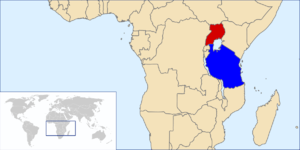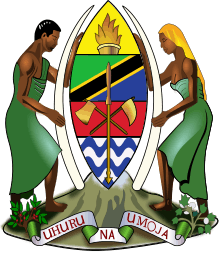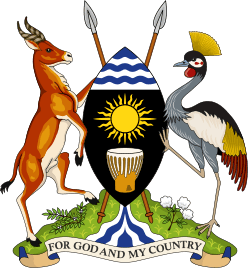Uganda–Tanzania War
Part of a series on the |
||||||||||
|---|---|---|---|---|---|---|---|---|---|---|
| History of Uganda | ||||||||||
 | ||||||||||
| Chronology | ||||||||||
|
||||||||||
| Special themes | ||||||||||
|
||||||||||
| By topic | ||||||||||
|
| ||||||||||
Part of a series on the |
|---|
| History of Tanzania |
 |
| Timeline |
| Colonial period |
| Modern history |
|
|
The Uganda–Tanzania War or Kagera War (commonly known in Uganda as the Liberation War) was fought between Uganda and Tanzania in 1978–1979, and led to the overthrow of Idi Amin's regime. Idi Amin's forces included thousands of troops sent by Libya.
Background
Relations between Tanzania and Uganda had been strained for several years before the war started. After Amin seized power in a military coup in 1971, the Tanzanian leader Julius Nyerere offered sanctuary to Uganda's ousted president, Milton Obote. Obote was joined by 20,000 refugees fleeing Amin's attempts to wipe out opposition. A year later, a group of exiles based in Tanzania attempted, unsuccessfully, to invade Uganda and remove Amin. Amin blamed Nyerere for backing and arming his enemies. With both sides accusing each other, the relationship between Uganda and Tanzania quickly reached an all-time low.
In early October 1978, dissident troops ambushed Amin at the presidential lodge in Kampala, but he escaped with his family in a helicopter.[4] This was during a period when the number of Amin's close associates had shrunk significantly, and he faced increasing dissent from within Uganda. When General Mustafa Adrisi, Amin's Vice President, was injured in a suspicious car accident, troops loyal to Adrisi (and other soldiers who were disgruntled for other reasons) mutinied. Amin sent troops against the mutineers (which included members of the elite Simba Battalion), some of whom had fled across the Tanzanian border. The rebellion spilled over into Tanzania, where Tanzania-based anti-Amin exiles joined the fighting against Amin's troops.
The war
Uganda declared a state of war against Tanzania on 30 October 1978, and sent troops to invade and annex part of the Kagera region of Tanzania, which Amin claimed belonged to Uganda.
Nyerere mobilized the Tanzania People's Defence Force and counterattacked. In a few weeks, the Tanzanian army was expanded from less than 40,000 troops to over 100,000 including members of the police, prison services, national service, and the militia. The Tanzanians were joined by several anti-Amin groups consisting of Ugandan exiles, who at a conference in Moshi (Moshi Conference) had united as the Uganda National Liberation Army (UNLA). These included Kikosi Maalum commanded by Tito Okello and David Oyite Ojok, FRONASA commanded by Yoweri Museveni, and Save Uganda Movement commanded by Akena p'Ojok, William Omaria, and Ateker Ejalu.
The Tanzanian Army acquired Soviet BM Katyusha rocket launchers (known in Uganda as saba saba), with which they started to fire on targets in Uganda.[5] The effect of powerful weapons like the Katyusha robbed the Ugandan forces of the initiative they had gained from the invasion, which had taken the Tanzanians by surprise as the country was totally unprepared to defend against an invasion. Furthermore, the use of multiple rocket launchers and other heavy weapons enabled the Tanzanian forces to make the Ugandan Army retreat steadily as it could not face up to the stronger and numerically superior Tanzanian Army that was now on the offensive against the demoralised Ugandan soldiers. Libya's dictator Muammar Gaddafi sent a Libyan expeditionary force of 2,500 troops to aid the Ugandan dictator Amin. The Libyan expeditionary force was equipped with T-54 and T-55 tanks, BTR APCs, BM-21 Grad MRLs, artillery, MiG-21s fighters, and one Tu-22 bomber.[6] The Libyan force was designed to primarily act as a supporting force for the Ugandan Army, and if necessary aid them in battle against the Tanzanians. However, soon after the force arrived in Uganda, the Libyan soldiers found themselves fighting the Tanzanians on the front line. Meanwhile, while the Libyans were fighting and dying in the fight to protect their ally's country, many of the Ugandan Army's units were using their own supply trucks to carry their newly acquired wealth taken from Tanzania back away from the front line.[7]
The Libyan troops were a mix of regular Libyan Army units, People's Militia, and sub-Saharan Africans of the Islamic Legion, a further force created by Libya for this type of expeditionary mission.[6] The Tanzanians, joined by UNLA dissidents, moved north for Kampala but halted at the vast deep-water swamp north of Lukaya. The Tanzanians decided to send the 201st Brigade directly across the causeway over the swamp while the better-quality 208th Brigade skirted the western edge of the swamp as an alternative in case the causeway was blocked or destroyed.
Between 10–12 March the Battle of Lukaya occurred between the Tanzanian Army and the Libyan Army alongside some Ugandan Army units. The battle started when a planned attack by a brigade-sized Libyan formation with fifteen T-55s, a dozen APCs, and BM-21 MRLs, intended to reach Masaka, instead collided with the Tanzanian force at Lukaya on 10 March and sent the 201st Brigade reeling backwards in disarray. However, a Tanzanian counter-attack on the night of 11 March from two directions, involving a reorganised 201st Brigade attacking from the south and the 208th Brigade from the north-west, was successful, with many Libyan units, including the militia, breaking and running away. Libyan casualties were reported at 200 plus another 200 allied Ugandans.[8]
Tanzanian and UNLA forces met little resistance after the Battle of Lukaya and carried on west toward Kampala, first taking the Entebbe airfield after some fighting, and then taking Kampala on 10 April 1979. Few Ugandan or Libyan units gave much resistance; the greatest problem for the Tanzanian troops was lack of maps of the city.[6] Amin fled, first to Libya and later to Saudi Arabia. The Libyan forces retreated to Jinja and then were repatriated finally through Kenya and Ethiopia. The Tanzanian army remained in Uganda to maintain peace while the UNLF (the political wing of the UNLA) organized elections to return the country to civilian rule.
The Tanzanian Government struck and distributed a campaign medal, known as the Nishani ya Vita. The obverse bears the inscriptions Vita-1978-1979 (top) and Tanzania (bottom). The reverse is plain.
Aftermath
Uganda
The period following the ousting of Amin was a time of intense competition and fighting for power among different groups of political and ethnic rivals. Yusuf Lule had been installed as president by Tanzania. In June 1979, following a dispute over the extent of presidential powers, the National Consultative Commission (NCC), which was then the supreme governing body of the UNLF, replaced Lule with Godfrey Binaisa. Binaisa was himself removed on 12 May 1980 by the Military Commission, a powerful organ of the UNLF headed by Paulo Muwanga and his deputy Yoweri Museveni (then leader of the Uganda Patriotic Movement). A Presidential Commission with three members, Saulo Musoke, Polycarp Nyamuchoncho, and Joel Hunter Wacha-Olwol were then appointed to lead the country. They governed Uganda until the December 1980 general elections, which were won by Milton Obote's Uganda Peoples Congress. The elections were bitterly disputed. Yoweri Museveni alleged electoral fraud and declared an armed rebellion against Obote's government, plunging the country into the Ugandan Bush War.
Tanzania
Tanzania received no help from other countries in the Organization of African Unity, which had denounced what was seen as an aggression by Tanzania (and its role as a backer of the 1977 coup in the Seychelles which brought France-Albert René to power) as a breach of national sovereignty. As a result, the government in Dar es Salaam had to foot the bill for the invasion and subsequent peacekeeping role from its own funds, further driving the country into poverty; Tanzania would not fully recover from the cost of the war until Uganda paid its debt back to Tanzania in 2007.[9]
Portrayal in media
- The film Rise and Fall of Idi Amin ends with the war, though it is portrayed in a very simplified way. Amin declares his intent to invade Tanzania, partially because of their support for anti-Amin guerrillas, as well as because "Uganda will then be very big on the map." After showing Ugandan troops invading Tanzania and stock footage of President Nyerere speaking, the narrator declares that a "30,000 strong disciplined army invaded Uganda." Ugandan defenses are easily overrun, and Amin and his advisers flee the country. Tanzanian troops are greeted as liberators by the Ugandan populace. As Bob Astles flees by boat, he laments, "I told that fool not to start a war with Tanzania."
See also
References
- ↑ "Idi Amin and Military Rule". Country Study: Uganda. Library of Congress. December 1990. Retrieved 5 February 2010.
By mid-March 1979, about 2,000 Libyan troops fighters had joined in the fight to save Amin's regime
- 1 2 3 4 5 Acheson-Brown, Daniel G. (2001). "The Tanzanian Invasion of Uganda: A Just War?" (PDF). International Third World Studies Journal and Review. 12: 1–11. Retrieved December 2013. Check date values in:
|accessdate=(help) - ↑ Foreigners Aided Amin, Washington Post, May 8, 1979.
- ↑ "An Idi-otic Invasion", TIME magazine, 13 Nov. 1978.
- ↑ "Fighting for Amin". The East African. 8 April 2002. Archived from the original on 8 March 2008. Retrieved December 2013. Check date values in:
|accessdate=(help) - 1 2 3 Pollack, Kenneth M (2002). Arabs at War: Military Effectiveness 1948–91. Lincoln and London: University of Nebraska Press. pp. 369–373. ISBN 0-8032-3733-2.
- ↑ "Armed Conflicts Event Data: Tanzanian-Ugandan War 1978-1979". OnWar.com. 16 December 2000. Retrieved December 2013. Check date values in:
|accessdate=(help) - ↑ "How Mbarara, Kampala fell to Tanzanian army". Daily Monitor. 27 April 2017. Retrieved 9 April 2018.
- ↑ Atuhaire, Alex B. (11 April 2007). "Uganda: Country Pays Tanzania Shs120 Billion Amin War Debt". AllAfrica.com. Retrieved December 2013. Check date values in:
|accessdate=(help) (subscription required)
- Tanzania Civil-military Relations and Political Stability

Further reading
- Mambo, Andrew; Julian, Schofield (2007). "Military Diversion in the 1978 Uganda-Tanzania War". Journal of Political and Military Sociology. Archived from the original on 8 November 2011.


